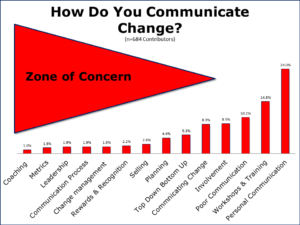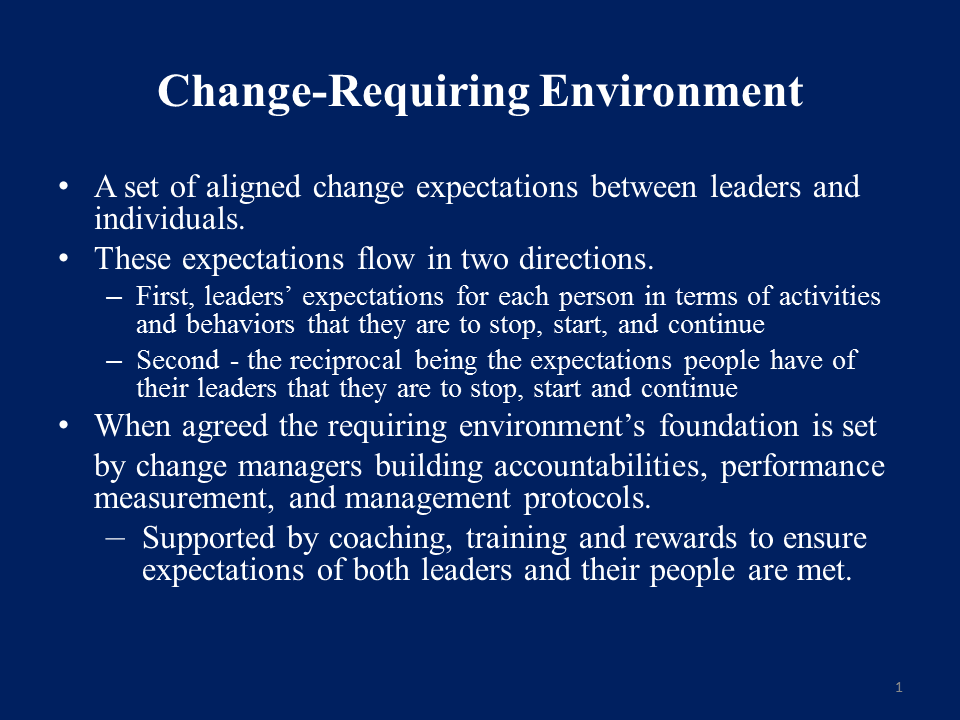Unsurprisingly, contributors see their people at the heart of any successful change process. They see gaining stakeholder commitment as a force multiplier of powerful change ambassadors. Essential to creating that commitment are leaders taking their people into their confidence with honesty and courage.
Surprisingly, however, our analysis also sheds light on some blind spots. Overall, contributors focus more on technique than systemic or strategic issues when communicating change. As one contributor put it:
- They (Leaders) lack the ability to motivate or hold people accountable….they do a poor job at this…..lots of saying nothing….People are told, not asked.
Change Communication Blind Spots

Real change requires authentic communication and dialogue across all organizational levels. Although, employee’s resistance and disagreement are unavoidable, contributors show how it can be managed through multiplexed and constant communication. They stress that this only happens when change communication is centered on establishing and retaining trusting relationships. If employees feel fairness, they will trust more and trust is the glue of success.
So, what role does communication play in reducing change mistrust and cynicism among employees? Frequently, it’s people’s sense of fairness. The communication timing, involvement and sequence impact their sense of justice.
The critical point is that “Change is Personal, Before It Can Be Organizational”
Leaders whose mindset that most people share the sames resistance and concern about change are to some degree right and to some degree flat out wrong. The safest route to effectively communicate change is face-to-face and one-on-one. In this way they can check out that state of their Psychological Contract and how individuals define it:
- “Individual beliefs, shaped by the organisation, regarding terms of an exchange agreement between individuals and their organisation”
- “Both parties perceptions of the employment relationship, organisation of the reciprocal promises, obligations and expectations implied in the relationship”
(adapted from Denise Rousseau)
Where’s the Requiring Environment
 There seems little focus on improving alignment and change success. Issues like change management, communication, and change measurement were under 6% of contributors’ comments on communicating change.
There seems little focus on improving alignment and change success. Issues like change management, communication, and change measurement were under 6% of contributors’ comments on communicating change.
Looking in more detail, a third of contributors said that they didn’t know of any change related communication or that their leaders don’t communicate enough.
For most contributors, real change is the outcome of authentic communication. They show how change can be managed through constant communication. Contributors often commented that trust in management was the only variable that significantly impacted change resistance.
However, comments on authentic communication and building trust seem to collide with those related to top down led change. Critical contributors point out that top down rests too often on leaders clinging to the belief that power, privilege and success lie in their core group. Whatever blend of top down and bottom up it is clear – one should be intentional and as one contributor said:
- Being solid in the values you hold as a leader that needs clearly articulating and solidifying with your change management team before you start planning.
Our contributors are clear. Lay the groundwork for successful change before trying to carry out the next change. This starts with putting the change management team together before a specific change is planned. Then develop a shared governing set of values and design the change measurement framework.
Action Points: Implementing an Effective Change-Communication Process
Based on your answers to the questionnaire above, use the following questions to develop your plan for developing effective change communication.
- Have you established an explicit set of shared governing values?
- How are you getting people ready for the inevitable change?
- Have you engaged stakeholders and change agents?
- Have you put the change-management team together?
- How do plan to align the team’s values of change and their expectations of one another?
- How are you going to improve leaders change communication skills?
- Who is going to ensure that real change will be the outcome of authentic communication?
- How are you going to ensure that all your people know and understand your change rationale?
- How are you going to monitor employee’s sense of fairness and trust? (Remember: trust is the glue of success.)
- How are you going to establish dialogue between groups and individuals, in often tense situations?
- How are you going to establish and monitor your change’s requiring environment? Is there a set of aligned change expectations between leaders and each individual?
For a Copy of Focusing Change To Win click here
